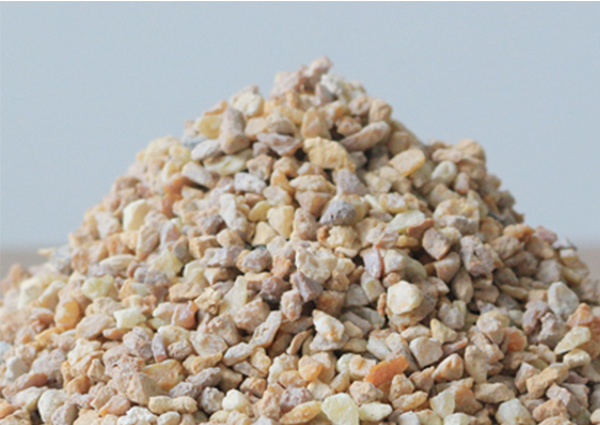Address: No. 1059, Pailou Village, Pailou Town, Haicheng City
Tel: Mr. Hu 15841201000
Mail box:1561481033@qq.com
Q Q:1561481033
Website:en.fadamining.com

General knowledge of magnesia
Magnesia can be divided into natural magnesia and seawater magnesia or synthetic magnesia. Natural magnesite mainly comes from natural magnesite, but it is difficult to obtain high-purity and high-quality products due to the quality constraints of raw ore. So far, seawater magnesite has become the main source of magnesite used in industrial developed countries. The theoretical content of MgO in magnesite is 47.3%. The other impurities are CaO, SiO 2 and iron. Magnesite is decomposed at 700 ~800 ~C in air, which is called "light burnt magnesia". When further heated to 1530 ~above, it becomes inactive periclase and becomes hard burnt magnesia, which is called "dead burnt magnesia". The synthetic seawater magnesia used in industrial production is made from seawater and digestive dolomite. MgO was obtained by calcining precipitated Mg(OH)2. The ratio of calcium to silicon in synthetic magnesia for unburned bricks was 0.3-0.5, and that of high purity seawater magnesia was over 1.7. The high temperature strength of magnesia was the highest. [2]
Properties of magnesia
The main chemical composition is MgO. The mineral composition is equiaxed system of periclase with density of 3.56-3.65 g/cm, Mohs hardness of 5.5, melting point of 2800 C and evaporation at 1800-2400 C. Pure periclase is colorless. With the increase of Fe2O3 and CaO content, its color changes from light to dark, showing yellow, brown and black-brown. The grain size of periclase increases with the increase of calcination temperature and holding time, and the hydration resistance and slag erosion resistance of periclase increase accordingly.
The impurities in magnesia come from dolomite, talc, tremolite and quartz in magnesite, so that magnesia contains SiO 2, AlO 3, FeO 3, CaO and other impurities (and B2O 3 in seawater magnesia). These impurities reduce the high temperature strength of magnesia. If the influence of Fe2O3 is taken as 1, compared with Cr2O3, Al2O3 and B2O3, the order is 1:3:11:70. In addition to periclase, mineral phases in magnesia can form various silicate minerals according to the ratio of CaO/SiO 2, which have different effects on the properties of magnesia products (Table 1).
According to the chemical composition of magnesia, the quality and phase composition of magnesia products can be predicted. When calculating the phase composition of magnesia products, only when the homogeneity of magnesia materials and the calcination temperature of magnesia materials are enough to make the phase composition reach equilibrium, the calculated phase composition will be consistent with the experimental results, and the higher the purity of materials, the more consistent.
Magnesite is decomposed to 700 ~C and discharged CO2. It is calcined to light burnt magnesite (caustic magnesia) at 1000 ~C. It is commonly known as bitter soil powder. Its texture is loose and its chemical activity is high. With the increase of temperature from 1700 to 1800 C, the grain size of periclase grows gradually, the volume shrinks, the density increases, and the chemical activity decreases greatly, that is to say, the calcined magnesia becomes sintered magnesia.
The main chemical composition is MgO. The mineral composition is equiaxed system of periclase with density of 3.56-3.65 g/cm, Mohs hardness of 5.5, melting point of 2800 C and evaporation at 1800-2400 C. Pure periclase is colorless. With the increase of Fe2O3 and CaO content, its color changes from light to dark, showing yellow, brown and black-brown. The grain size of periclase increases with the increase of calcination temperature and holding time, and the hydration resistance and slag erosion resistance of periclase increase accordingly.
The impurities in magnesia come from dolomite, talc, tremolite and quartz in magnesite, so that magnesia contains SiO 2, AlO 3, FeO 3, CaO and other impurities (and B2O 3 in seawater magnesia). These impurities reduce the high temperature strength of magnesia. If the influence of Fe2O3 is taken as 1, compared with Cr2O3, Al2O3 and B2O3, the order is 1:3:11:70. In addition to periclase, mineral phases in magnesia can form various silicate minerals according to the ratio of CaO/SiO 2, which have different effects on the properties of magnesia products (Table 1).
According to the chemical composition of magnesia, the quality and phase composition of magnesia products can be predicted. When calculating the phase composition of magnesia products, only when the homogeneity of magnesia materials and the calcination temperature of magnesia materials are enough to make the phase composition reach equilibrium, the calculated phase composition will be consistent with the experimental results, and the higher the purity of materials, the more consistent.
Magnesite is decomposed to 700 ~C and discharged CO2. It is calcined to light burnt magnesite (caustic magnesia) at 1000 ~C. It is commonly known as bitter soil powder. Its texture is loose and its chemical activity is high. With the increase of temperature from 1700 to 1800 C, the grain size of periclase grows gradually, the volume shrinks, the density increases, and the chemical activity decreases greatly, that is to say, the calcined magnesia becomes sintered magnesia.
Table 1 Effect of matrix composition in magnesia on properties of products
Mineral melting point or
Decomposition temperature
Mohr's hardness at /(?) C has other effects on properties of magnesia products
Sintering Load Softening Temperature and Compressive Strength
Forsterite 18906.5-7 is unfavorable to increase
Decomposition of Calcium-Magnesium Olivine 1498 by 5-5.5 Promotes Decomposition of Calcium-Magnesium Olivine
Magnesium silicate 1550 difference decreases slightly
Calcium dicalcium silicate 2130 is poorly improved and has good slag resistance especially when the crystal form is changed.
The decomposition of tricalcium silicate 1900 is poor and improved
